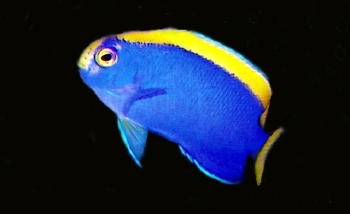
By Bob Goemans

Likely Reef Tank Suitable
Likely Fish-Only Tank Suitable
Range: Central Atlantic Ocean: Helena and Ascension Islands
Size: 2.5 inches (6 cm)
Natural Environment: Inhabits near shore rocky and rubble bottom areas, at a depth of 50 to 130 feet (15 – 40 m) and diet consist mainly of algae and detritus.
General Husbandry: This beautiful dwarf angelfish has a deep blue colored body with yellow coating its face area and extending onto the top of its body to the tail, which is also yellow. This often quite expensive species is rarely seen in the aquarium trade, as only captive bred specimens are allowed in the trade.
Its recommended this species be added to a well-established reef or fish-only aquarium, as it likes to pick on rocks containing various forms of algae or find accumulations of detritus to ingest. In fact, its an excellent browser of algae, and will also accept a wide variety of frozen foods including fortified brine shrimp, mysis, and flake food, especially Spirulina. Two feedings per day is highly recommended. Its also recommended there be only one species from this the dwarf angelfish genus in the aquarium, as they not only aggression toward other dwarf angelfish, they are also aggressive to all tankmates except much larger and aggressive species! Its also recommended it be the last fish to be added as it can be quite feisty with newcomers, small or large.
Taxonomy:
Order: Perciformes
Suborder: Percoidei
Family: Pomacanthidae
Genus: Centropyge
FYI: All Centropyge species start life as unsexed individuals, but begin their adult life as females. Then, the larger or more dominant individual within small groups will change sex within a few days to a couple of weeks and become a male. Knowing that size is the main difference between the sexes, and not so much its coloration, all one needs to do is place a small and larger specimen together. Within approximately sixty days one of the two fish will have physically changed sex to accommodate the other. A reversal of this sex change is possible if the need arises, but that requires much more time, e.g., weeks to months.
Keep in mind all angels have cheekspines at the edge of their gill cover; therefore use caution when handling and also avoid using a net to capture it, as it may become stuck or tangled in the net and become damaged when removed.
Wild caught specimens are illegal.
Experience Level: Intermediate
Temperament: Semi-aggressive
Diet: Omnivore
Acclimation Time: 30 minutes+
Aquarium Environment: Reef aquarium (see below) or fish-only aquarium
Reef Safe: With caution – has a tendency to nip clam mantles, large–polyped stony (LPS) corals and some soft corals such as zoanthids, especially so when underfed.
Minimum Tank Size: 30 gallons
Temperature Range: 68 - 79°F (20 – 26°C).
Specific Gravity: 1.020-1.027
pH: 8.0 - 8.5
